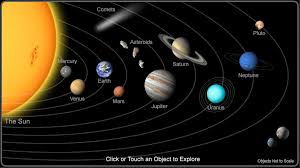The Wonders of Our Solar System
The solar system, our celestial neighborhood, is a fascinating and awe-inspiring place that has captured the curiosity of humanity for centuries. Comprising the sun, eight planets, numerous moons, asteroids, comets, and other celestial bodies, the solar system offers a glimpse into the vastness and complexity of the universe.
The Sun: Our Life-Giving Star
At the center of the solar system lies the sun, a massive ball of hot plasma that provides light and heat to sustain life on Earth. It is by far the largest object in our solar system, containing more than 99% of its total mass.
The Planets: Diverse Worlds in Orbit
Mercury, Venus, Earth, Mars, Jupiter, Saturn, Uranus, and Neptune are the eight planets that orbit the sun in varying distances. Each planet has its own unique characteristics and features, from Mercury’s scorching temperatures to Neptune’s icy blue hue.
Moons and Other Bodies
Many planets in our solar system have moons orbiting around them. For example, Jupiter has over 70 moons while Saturn boasts its iconic rings made up of countless icy particles. Moons like Europa (Jupiter’s moon) and Titan (Saturn’s moon) have intrigued scientists with their potential for hosting life.
Exploration and Discovery
Over the years, space agencies like NASA and ESA have sent numerous spacecraft to explore different parts of our solar system. Missions like Voyager, Cassini-Huygens, Curiosity Rover have provided valuable insights into planetary geology, atmospheres, and potential for habitability.
The Future of Solar System Exploration
As technology advances and our understanding of space deepens, there are exciting prospects for further exploration within our solar system. From planned missions to Mars to potential missions to study distant moons like Enceladus or Europa for signs of life; the future holds immense possibilities for unraveling more mysteries of our cosmic backyard.
In conclusion, our solar system stands as a testament to the beauty and complexity of nature. It serves as a reminder of how interconnected we are with the wider universe and inspires us to continue exploring beyond our own planetary boundaries.
“Exploring the Cosmos: Five Fascinating Facts About the Solar System”
3. “The Solar Hierarchy: Listing the 12 Planetary Bodies
- Are there 14 planets in our solar system?
- What are 5 interesting facts about the solar system?
- What are the 12 planets in order from the Sun?
- What are the 9 planets in the solar system?
Are there 14 planets in our solar system?
The question of whether there are 14 planets in our solar system often arises due to varying definitions of what constitutes a planet. In the traditional sense, there are eight recognized planets in our solar system: Mercury, Venus, Earth, Mars, Jupiter, Saturn, Uranus, and Neptune. However, the debate over Pluto’s planetary status has led to differing opinions. Some argue that Pluto should be reinstated as the ninth planet, while others maintain that it does not meet the criteria set by the International Astronomical Union (IAU) in 2006. Beyond Pluto, there are other celestial bodies like dwarf planets and trans-Neptunian objects that add complexity to the question of planetary count in our solar system.
What are 5 interesting facts about the solar system?
The solar system is a treasure trove of fascinating facts that never fail to captivate our imagination. Here are five intriguing tidbits about our cosmic neighborhood: Firstly, the asteroid belt located between Mars and Jupiter is home to millions of rocky bodies, remnants of the early solar system’s formation. Secondly, Saturn’s mesmerizing rings are not solid structures but rather made up of countless icy particles orbiting the planet in a delicate dance. Thirdly, Venus experiences a phenomenon known as a “retrograde rotation,” where it spins in the opposite direction to most other planets. Fourthly, Jupiter, the largest planet in our solar system, has a staggering 79 moons, including Ganymede, the largest moon in the solar system. Lastly, Pluto, once considered the ninth planet, was reclassified as a dwarf planet in 2006, sparking debates and discussions about planetary definitions and classifications. These facts offer just a glimpse into the rich tapestry of wonders that await exploration within our solar system.
What are the 12 planets in order from the Sun?
In our solar system, there are eight recognized planets that orbit the Sun in order of their distance: Mercury, Venus, Earth, Mars, Jupiter, Saturn, Uranus, and Neptune. In 2006, Pluto was reclassified as a dwarf planet by the International Astronomical Union (IAU), leading to the current understanding that there are eight planets in our solar system. While there may be other celestial bodies beyond Neptune’s orbit, they are not officially recognized as planets according to the current definition.
What are the 9 planets in the solar system?
In the past, it was commonly believed that there were nine planets in our solar system. However, with advancements in scientific understanding and reclassification by the International Astronomical Union in 2006, the official count of planets in our solar system is now eight. These eight planets are Mercury, Venus, Earth, Mars, Jupiter, Saturn, Uranus, and Neptune. Pluto, which was previously considered the ninth planet, has been reclassified as a dwarf planet due to its size and characteristics differing from the other eight planets. This change highlights the dynamic nature of scientific knowledge and classification systems in our exploration of the cosmos.

